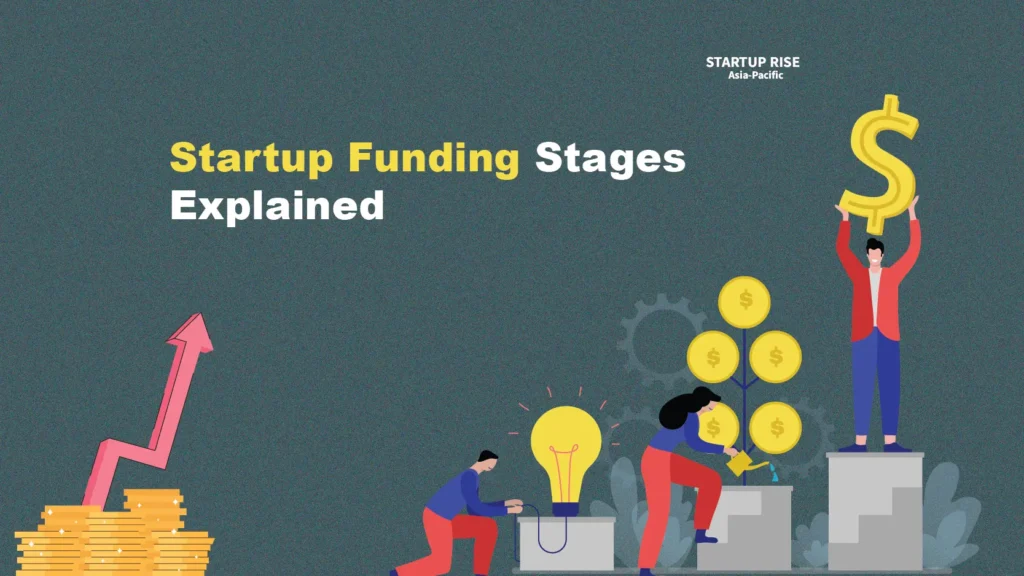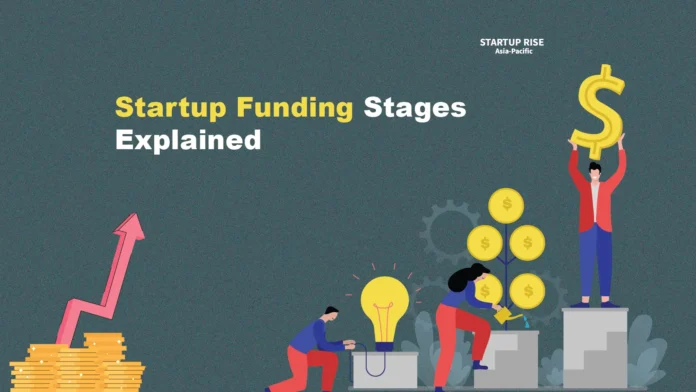
What are the startup funding stages?
Startup funding moves through a number of important phases, each essential to the expansion of the business. Pre-Seed and Seed investment are the first steps, helping to establish the business. As the business grows, it advances through a number of Series funding rounds (A, B, C, etc.) and ultimately strives for an IPO, which would represent the apex of its achievement.
Startups are fresh and untested, so early-stage funding carries a high risk. This start-up money helps with necessary projects including product development, research, and early operations. Every investment round signifies an important turning point in a startup’s history and reflects its objectives for expansion and development. Throughout the startup’s growth, investors—including venture capitalists and angel investors—play a critical role by offering both financial support and strategic direction.

Table of Contents
Startup funding stages explained
For a startup to grow successfully, funding goes through multiple stages. Here, we go over the steps involved in startup finance and the operation of the IPO process.
Different Startup Funding Stages
1. Pre-seed funding
The initial round of startup funding is known as pre-seed funding, and it is provided by incubators, friends, family, and founders.
- A few thousand dollars to $1 million in funds are available.
- These funds are used by entrepreneurs to create prototypes, study the market, and improve business plans.
- It facilitates the establishment of pilot projects and proof of concept.
- Due to the high risk and potential for large profits,investors are drawn to it. They frequently invest to fund early growth and acquire initial stock.
- Pre-seed money, while not included in official funding rounds, is essential for launching and validating a firm.
- It establishes the foundation for further fundraising endeavors.
2. Seed funding
The first phase of external finance for launching a business is known as seed capital.
- Angel investors, friends, family, venture capital firms, and incubator programs are the sources of funding.
- During this phase, startups usually raise about $3.5 million.
- It assists new businesses with well-defined concepts in product development and market strategy optimization.
- It assists with product development, team building, and market research in order to turn an idea into a successful business.
- Angel investors are particularly interested in early-stage stock opportunities at discounted prices during this phase.
- Seed investment is necessary for the launch of a firm that has not yet made a name for itself in the market, despite the increased risks involved.
Read more – Top 10 Early-Stage Startup Accelerators 2024-2025
3. Series A Funding
For entrepreneurs looking to expand and fortify their position in the market, the Series A Funding Stage is essential.
The usual funding amount is between $2 million and $15 million. Once robust financial performance and commercial viability have been confirmed, it encourages gradual expansion.
Networking with angel investors and venture capitalists is crucial because accelerators provide startups with money and mentoring in exchange for stock.
Investors are looking for businesses that have a strong long-term business plan for consistent revenue, multiple product prototypes, and identified target markets.
The amount of equity investors receive, the startup’s financial structure, and its prospects for growth are all influenced by valuations, which are based on historical sales, growth rates, market size, and risks.
4. Series B funding
The second significant round of investment for startups is called Series B, and it focuses more on increasing operations than on setup..
- The amount of funding is between $5 and $50 million.
- Preferred stock is usually purchased by venture capitalists; huge corporations and financial institutions are examples of strategic investors.
- The funds are allocated towards fortifying infrastructure, expanding sales teams, hiring essential personnel, scaling operations, and initiating marketing initiatives.
- Following demonstrating notable market expansion and success, startups often look for Series B funding approximately two years following Series A.
- Higher risk is associated with Series B funding, and investors may ask for more stake. During talks, founders must safeguard their stock and guarantee fair valuation.
5. Series C Funding
The third level of venture capital investment, known as series C funding, is concentrated on quick development and expansion.
- The funding amount varies between $30 million and $100 million.
- Participating institutions include private equity firms, investment banks, and hedge funds.
- Funds are used for future acquisitions, debt repayment, equity buyback, expanding cash reserves, and breaking into new markets. They also assist research and development.
- It gets the business ready for big achievements like an acquisition, IPO, or substantial growth.
- At this point, businesses are well-established, have a sizable client base, significant revenues, and a solid development trajectory, all of which attract top-tier investors.
6. Series D Funding
Before a corporation chooses to go public or buy out another company, it goes through the Series D Funding Stage.
- It seeks to improve resources and capacities even more, frequently as a result of unrealized potential or inadequate Series C outcomes.
- Venture capitalists are the primary source of funding, which can vary from millions to billions of dollars.
- Less than 5% of startups make it to Series D or E, frequently because they need to grow their operations or raise their values in order to go public.
- If they failed to meet goals in earlier rounds, some businesses look for Series D or E funding, which might lead to a “down round” with reduced values and possible fundraising difficulties.
- Most startups fail after the first round of Series A fundraising, and most proceed through three to four funding rounds before preparing for an IPO after Series C.
7. IPO
IA corporation offers its shares to the public for the first time during the initial public offering (IPO) stage in order to raise a sizable sum of money.
- The primary objectives are to raise capital for expansion, improve the company’s reputation, and enable initial investors to liquidate their shares.
- Banks assist in the share sales process, and the company must complete all necessary paperwork and adhere to SEC laws.
- The pinnacle of startup success, an IPO is essential for raising significant capital and being visible on the public market.
- Important actions include assembling a team of SEC specialists, attorneys, accountants, and underwriters for the public offering, gathering the financial data for the business, creating an audit of the financial statements, and fulfilling legal and regulatory requirements for initial public offerings.
- The initial public offering (IPO) helps raise capital for expansion and gives company founders the opportunity to sell their shares for profit.
Startup Funding Stages Funding Stages
- Pre-seed funding: $1 million
- Seed funding: $3.5 million
- Series A funding: $2 million – $15 million
- Series B funding: $5 million – $50 million
- Series C funding: $30 million – $100 million
- Series D funding: millions to billions of dollars
- IPO: Varies
Other types of funding
If your company isn’t a good fit for Series A, B, or C finance, there are a number of other methods for obtaining funds. By taking into account the following, startups can expand their funding sources beyond stock and venture capital:
Using a platform to raise money from a large number of people, frequently in exchange for goods or features that validate product concepts and expand the client base without reducing equity.
Obtaining loans for small businesses from lenders that supply cash without losing equity, even though debt financing may be more expensive than stock offerings.
Securing non-refundable funds from government agencies or charitable groups, which can provide assistance for particular projects or campaigns that meet grant requirements.
Offering investors a portion of future profits in return for quick cash; this allows for flexible payback schedules based on sales, but it may be expensive if sales are erratic or the company expands quickly.
Conclusion
It’s essential to comprehend startup fundraising rounds in order to analyze opportunities and interpret news. At every level, investors exchange cash for equity, and they have varied requirements for businesses. From Seed to Series A, B, and C, each step contributes to the development of ideas but differs in risk and maturity. Investors can help firms with series capital and even make money from an IPO.
Not every startup takes the same route to fundraising; depending on their needs, some may skip or rerun some steps. Mezzanine and bridge financing are two more funding solutions that might offer further assistance during transitional times. This information is essential for entrepreneurs hoping to launch successfully.
FAQs
Q1. What are Startup funding stages?
Startup funding moves through a number of important phases, each essential to the expansion of the business.
Q2. What is IPO?
A corporation offers its shares to the public for the first time during the initial public offering (IPO) stage in order to raise a sizable sum of money.
Q3. What are the startup funding stages?
The stages of startup finance include pre-seed, seed, and series (a, b, and c).





